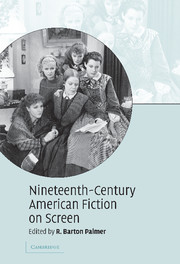Book contents
- Frontmatter
- Contents
- List of illustrations
- Notes on contributors
- Acknowledgments
- Introduction
- 1 A very American fable: the making of a Mohicans adaptation
- 2 Romancing the letter: screening a Hawthorne classic
- 3 The movies in the Rue Morgue: adapting Edgar Allan Poe for the screen
- 4 Readapting Uncle Tom's Cabin
- 5 Screening authorship: Little Women on screen 1933–1994
- 6 Melville's Moby-Dick and Hollywood
- 7 Screening male sentimental power in Ben-Hur
- 8 John Huston's The Red Badge of Courage
- 9 Translating Daisy Miller
- 10 Jane Campion's The Portrait of a Lady
- 11 The Europeans – and the Americans
- 12 Sister Carrie becomes Carrie
- 13 Hollywood and The Sea-Wolf
- 14 An untypical typicality: screening Owen Wister's The Virginian
- Filmography
- Index
2 - Romancing the letter: screening a Hawthorne classic
Published online by Cambridge University Press: 22 December 2009
- Frontmatter
- Contents
- List of illustrations
- Notes on contributors
- Acknowledgments
- Introduction
- 1 A very American fable: the making of a Mohicans adaptation
- 2 Romancing the letter: screening a Hawthorne classic
- 3 The movies in the Rue Morgue: adapting Edgar Allan Poe for the screen
- 4 Readapting Uncle Tom's Cabin
- 5 Screening authorship: Little Women on screen 1933–1994
- 6 Melville's Moby-Dick and Hollywood
- 7 Screening male sentimental power in Ben-Hur
- 8 John Huston's The Red Badge of Courage
- 9 Translating Daisy Miller
- 10 Jane Campion's The Portrait of a Lady
- 11 The Europeans – and the Americans
- 12 Sister Carrie becomes Carrie
- 13 Hollywood and The Sea-Wolf
- 14 An untypical typicality: screening Owen Wister's The Virginian
- Filmography
- Index
Summary
In The Office of The Scarlet Letter (1991), Sacvan Bercovitch calls Nathaniel Hawthorne's famous novel, written nearly a century and a half earlier (1850), “our most enduring classic.” This glowing compliment echoes dozens of others, including Henry James's judgment of 1887: “It is beautiful, admirable, extraordinary; it has in the highest degree that merit which I have spoken of as the mark of Hawthorne's best things – an indefinite purity and lightness of conception.” As these critical valentines attest, Hawthorne (1804–64) is one of America's indisputably canonical authors, and The Scarlet Letter is generally conceded to be his ultimate achievement. It is only to be expected, then, that there would be one or more attempts to present The Scarlet Letter on film. Mark Axelrod explains that “particular texts are preferable for standardization and exploitation within the Hollywood film industry because of the way they are written,” so it comes as no surprise that Hawthorne's artful, stimulating, highly symbolic narrative should have been frequently chosen for cinematic adaptation. For most of the twentieth century, from “artistic” silents, through studio entertainments obviously aimed at a mass audience, and high-minded European art films, all the way down to a starring vehicle for Demi Moore, The Scarlet Letter has been repeatedly adapted from the page to the screen. Curiously enough, these film versions simultaneously recognized the excellence of Hawthorne's classic text and sought to “improve” that text by adjusting it to the values of the contemporary cultures into which the films were released.
- Type
- Chapter
- Information
- Nineteenth-Century American Fiction on Screen , pp. 29 - 42Publisher: Cambridge University PressPrint publication year: 2007
- 1
- Cited by



